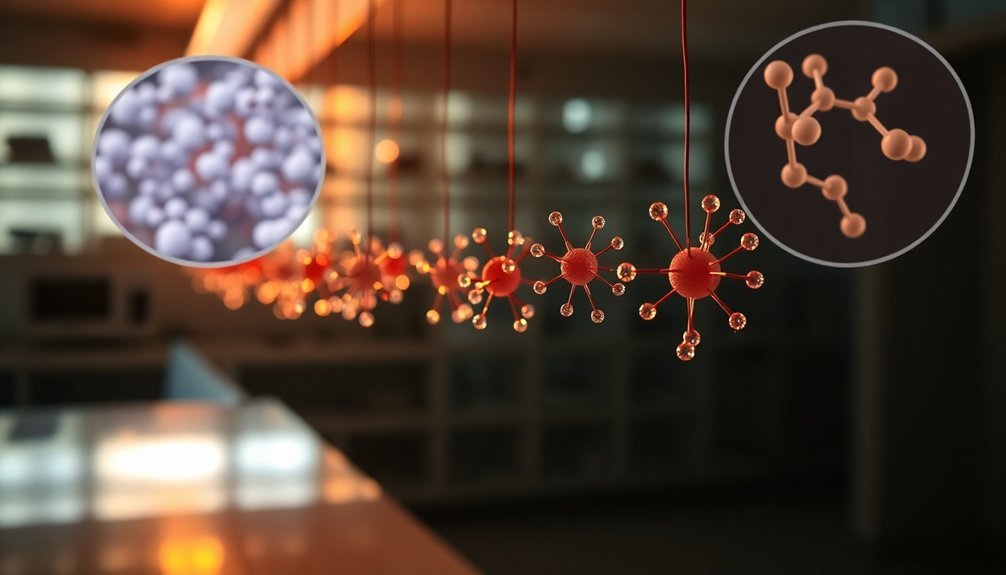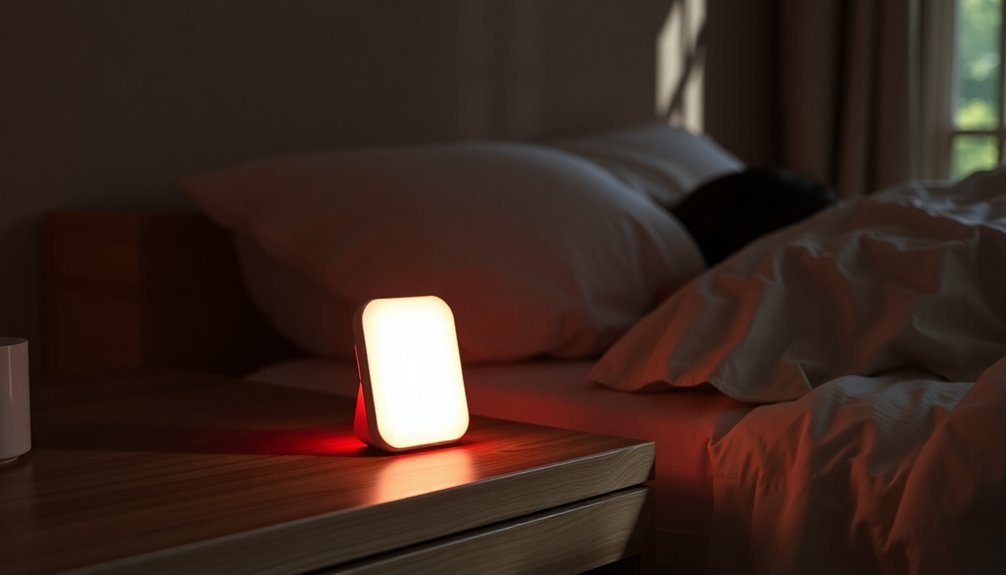Infrared rays can boost your melatonin production by enhancing mitochondrial function. Mitochondria are vital for producing melatonin, and infrared light helps energize these significant cellular powerhouses. It promotes the best light conditions needed for melatonin synthesis by reducing the effects of blue light, which usually suppresses melatonin levels in the evening. When you expose yourself to red or near-infrared light before bedtime, you encourage your body to produce more melatonin, improving your sleep quality. This simple adjustment can align your sleep-wake cycles better. Discover more about how light therapies support your overall well-being.
Mechanism of Melatonin Production

Melatonin production is a fascinating biochemical process that begins with L-tryptophan, an essential amino acid sourced from protein breakdown or the shikimate pathway. This amino acid undergoes hydroxylation by tryptophan hydroxylase, producing 5-hydroxytryptophan (5-HTP).
Then, 5-HTP is decarboxylated by 5-hydroxytryptophan decarboxylase, transforming it into serotonin.
Next, serotonin is converted to N-acetylserotonin by serotonin N-acetyltransferase, which utilizes acetyl-CoA in this step. Finally, melatonin forms through the methylation of N-acetylserotonin by hydroxyindole O-methyltransferase.
The entire pathway is intricately regulated by the suprachiasmatic nucleus (SCN) in the hypothalamus, which responds to light and darkness. When it's daylight, the SCN reduces melatonin synthesis, while at night, it stimulates production. Melatonin levels are known to peak around 3 to 4 AM and drop to undetectable levels with morning light.
Fundamentally, the pineal gland is instructed by the SCN to synthesize melatonin based on light signals, peaking at night and decreasing with morning light.
Nutritional factors can influence this process, as tryptophan availability and certain vitamins affect melatonin levels, though light remains the primary regulator of its biosynthesis.
Infrared Light and Cellular Impact
Infrared light plays a crucial role in boosting mitochondrial function, making it essential for cellular energy production. It also helps reduce reactive oxygen species, which can harm your cells and lead to oxidative stress. Furthermore, the enhancement of mitochondrial absorption due to infrared light contributes to improved cellular energy production.
Mitochondrial Function Enhancement
When it comes to enhancing mitochondrial function, utilizing near-infrared (NIR) light offers remarkable benefits for cellular health. NIR light boosts ATP production, which is essential for your cells' energy needs. By activating cytochrome c oxidase, a vital enzyme in the mitochondrial electron transport chain, NIR light promotes oxygen consumption and additionally increases ATP generation.
You'll also notice improved cellular respiration with NIR therapy, leading to a more efficient energy metabolism. Moreover, NIR light enhances protein synthesis, aiding in cellular repair and overall function. By improving mitochondrial membrane potential, the result is healthier, more functional mitochondria. NIR therapy reduces COX activity effectively, allowing for a controlled modulation of mitochondrial function without complete inhibition.
NIR therapy effectively reduces mitochondrial swelling, a sign of damage, while promoting mitophagy—the process that clears out dysfunctional mitochondria. This keeps your mitochondrial quality control in check and maintains their structural integrity.
In addition, NIR light aids recovery of mitochondrial function after ischemic events, demonstrating its importance in preserving cellular health.
Incorporating NIR light therapy into your routine can greatly enhance mitochondrial function, ensuring your body operates at its best while promoting overall wellness.
Reactive Oxygen Species Reduction
Exposing cells to near-infrared (NIR) light can markedly influence the generation and reduction of reactive oxygen species (ROS). When you apply NIR light, it could increase ROS levels, particularly in inflamed cells, which might lead to the production of compounds like hydrogen peroxide and superoxide radicals. This brief spike in ROS can kick-start anti-inflammatory mechanisms vital for your cellular health.
However, the beauty of NIR light exposure is that it's context-dependent; the same treatment won't produce the same effect in healthy cells.
If you repeatedly expose your cells to NIR light, you'll likely notice a significant decline in intracellular ROS levels. This happens because NIR light helps your body ramp up the expression of genes responsible for ROS-scavenging enzymes. Reduced ROS levels play an essential role in alleviating oxidative stress, benefiting overall cell function.
Moreover, the interplay between ROS and inflammation is remarkable. The transient increase in ROS helps to downregulate inflammatory cytokines, lending NIR therapy its anti-inflammatory benefits.
Mitochondria's Role in Melatonin

Mitochondria often play an essential role in melatonin synthesis and metabolism, making them important for overall cellular function. In fact, they're where melatonin is synthesized, transported, and metabolized, with concentrations approximately 100 times higher than in plasma. The significant enzyme for melatonin production, AANAT, resides within the mitochondria of pinealocytes and oocytes, ensuring efficient synthesis.
Here are some key functions of mitochondria related to melatonin:
- Energy Regulation: Melatonin influences mitochondrial metabolism by affecting acetyl-CoA concentration, impacting glycolysis and fatty acid metabolism.
- Mitochondrial Dynamics: It inhibits fission while promoting fusion, stabilizing mitochondrial function to maintain energy supply.
- Protective Mechanisms: Melatonin protects against mitochondrial injury, regulates biogenesis, and helps maintain a proper redox state, essential for homeostasis.
Optimal Timing for Light Exposure
Ideal light exposure is essential for aligning your body's melatonin production with your circadian rhythms. To optimize melatonin release, you should aim to get morning light exposure as early as possible. Spending 30 minutes in light that's around 10,000 lux can greatly advance your melatonin rhythm. The earlier you do this, the better the effects, especially if you experience seasonal affective disorder.
Conversely, be cautious with evening light exposure, particularly blue light, as it can hinder melatonin production and delay your natural rhythm. Instead of bright screens, consider using dim red or near-infrared light 1-2 hours before bedtime. This can actually aid melatonin levels rather than suppress them.
Timing matters too. Morning light should ideally occur 7.5 to 11 hours after your melatonin onset for the best results. Evening light exposure should be avoided as night progresses to prevent larger delays in melatonin secretion.
Effects of Light Conditions

Light conditions greatly influence melatonin production, impacting your overall sleep quality and health. The wavelengths and intensity of light you're exposed to can either hinder or help your melatonin levels.
For instance, short-wavelength light, particularly blue light, can considerably suppress melatonin production, especially when exposed in the evening. On the other hand, long-wavelength light, like red and near-infrared, helps maintain healthy melatonin levels.
Here are a few key points to reflect on:
- Minimize blue light: Limit exposure to blue light, especially after dusk, to support natural melatonin production.
- Manage light intensity: Even low-intensity light can suppress melatonin levels during the evening; verify your environment is dim in the hours leading up to bedtime.
- Be mindful of duration: Prolonged exposure to any light source can delay your circadian rhythm, so aim for shorter light exposure in the evening.
Clinical Benefits of Infrared Therapy
You might find that infrared therapy notably boosts your sleep quality thanks to its role in supporting melatonin production.
Additionally, its anti-inflammatory effects can help reduce discomfort and promote overall relaxation, making it a great option for improving well-being.
Improved Sleep Quality
In recent years, infrared therapy has emerged as a promising solution for those seeking improved sleep quality. By regulating your circadian rhythms, this therapy helps synchronize your internal clock, which is essential for maintaining healthy sleep-wake cycles.
When you expose yourself to red and near-infrared light, especially in the evening, it can boost melatonin production, making it easier for you to fall asleep and stay asleep.
Consider these benefits of infrared therapy:
- Enhanced Melatonin Production: Aligns your melatonin levels with your desired sleep schedule.
- Reduced Stress and Anxiety: Creates a relaxed state, promoting better sleep quality.
- Improved Sleep Parameters: Reduces sleep latency, leading to a refreshed feeling in the morning.
With consistent use of infrared light, you'll likely notice a shift in your body's circadian rhythm, facilitating better sleep timing.
Many users report increased relaxation and mood improvement, which contribute to an overall better sleep experience.
Anti-inflammatory Effects
Infrared therapy not only enhances sleep quality but also exhibits notable anti-inflammatory effects. By penetrating deep into your tissues, this therapy stimulates endorphin production, easing pain and reducing inflammation. For people suffering from conditions like knee osteoarthritis or lower back pain, infrared therapy has shown significant benefits, making activities more manageable.
| Benefit | Mechanism |
|---|---|
| Reduces pain | Increases endorphin levels |
| Enhances blood circulation | Delivers nutrients and oxygen to tissues |
| Stimulates ATP production | Boosts cellular energy for repair |
| Manages chronic inflammation | Improves cellular repair |
| Facilitates tissue regeneration | Aids in the recovery of damaged tissues |
Moreover, infrared light triggers metabolic processes, increasing nitric oxide levels that aid in vasodilation. This effect helps your body combat free radicals, while also improving the production of essential molecules involved in inflammation. With various therapeutic applications, such as treating chronic low back pain and fibromyalgia, infrared therapy proves to be a viable option, supporting your overall health and well-being.
Enhancing Sleep With Light

Light plays a critical role in enhancing sleep quality, with its influence on melatonin production being particularly significant.
Exposure to light, especially blue light, can suppress melatonin secretion and shift your circadian rhythms. Even dim light affects melatonin levels, making it essential to manage your light environment, particularly in the evenings.
To optimize your sleep, consider these tips:
- Limit blue light exposure in the evening by using blue light filters on screens.
- Switch to dim red lights when moving to nighttime; they're less likely to interfere with melatonin production.
- Create a calming bedtime routine that includes reducing light levels in your home at least one hour before sleep.
Practical Uses of Light Therapy
Managing your light exposure not only enhances sleep by supporting melatonin production but also opens the door to various practical uses of light therapy.
If you're struggling with mood disorders like Seasonal Affective Disorder (SAD) or depression, incorporating light therapy can stabilize your circadian rhythm and improve your mood. It's often used alongside traditional treatments during pregnancy, in cases of premenstrual depression, or even with certain personality disorders.
Similarly, if you're dealing with skin conditions like psoriasis or cystic acne, LED and UV light therapies can be remarkably effective.
Red light therapy boosts cell energy, reduces inflammation, and hydrates your skin, while blue LED light targets acne bacteria and controls oil production.
Light therapy also shines bright when it comes to alleviating chronic pain. By promoting healing and diminishing inflammation, it can ease symptoms for conditions like fibromyalgia.
It even helps manage stress by regulating hormones.
Lastly, light therapy supports your overall health – from improving circulation and skin health to aiding in wound healing.
With its vast benefits, effectively managing your light exposure can be a game-changer for both your physical and mental well-being.
Choosing Effective Light Devices

Selecting the right light devices is essential for optimizing your melatonin production and overall well-being. To effectively enhance your melatonin levels, focus on devices that use specific wavelengths and appropriate intensities. Look for red and near-infrared light that falls between 660-850 nanometers. Avoid blue light, particularly in the evening, as it can suppress melatonin production.
Here are a few key features to take into account when choosing your light devices:
- FDA Approval: Verify your device is FDA-cleared for safety and efficacy.
- Intensity Levels: Look for devices that provide adjustable intensity tailored to your treatment needs.
- User-Friendly: Think about options with timer settings or remote controls for convenience.
Additionally, assess the coverage type—whether you need full-body panels or targeted handheld devices.
Investing in high-quality products backed by clinical research is fundamental for achieving the desired results safely. Always check user reviews to gauge real-world effectiveness.
Frequently Asked Questions
Can I Use Infrared Light Therapy During the Day?
You can use infrared light therapy during the day, but it won't have the same impact on melatonin production. It's great for relaxation and other therapeutic benefits, just avoid using it when preparing for sleep.
Are There Any Side Effects From Red and NIR Light Exposure?
Yes, there can be side effects from red and near-infrared light exposure, including mild skin irritation, eye strain, or headaches. It's essential you follow guidelines and wear protective eyewear during treatments to minimize risks.
How Long Should I Use Infrared Light for Best Results?
For ideal results, use infrared light therapy for 10 to 30 minutes daily, especially in the evening. Consistent exposure, around five days a week, enhances benefits and helps regulate your sleep patterns effectively.
Can Infrared Light Help With Other Health Issues Besides Sleep?
Yes, infrared light can help with various health issues beyond sleep. It improves cardiovascular health, boosts immune function, enhances skin elasticity, reduces chronic pain, and supports detoxification by promoting increased blood flow and collagen production.
Is There a Specific Distance I Should Maintain From Light Therapy Devices?
For light therapy, you should maintain a specific distance based on your treatment goal. Generally, stay 8 to 12 inches for skin health, 6 to 8 inches for muscle soreness, and adjust according to device guidelines.
In Summary
Incorporating infrared light into your routine can greatly enhance melatonin production, ultimately improving your sleep quality. By understanding how this light impacts your cells and mitochondria, you can utilize it effectively. Timing and environment matter, so make sure to create conditions that promote restful sleep. Whether through therapy or specific devices, harnessing the power of infrared light might just be the key to a better night's rest. Embrace this simple yet powerful tool for your well-being!





Leave a Reply